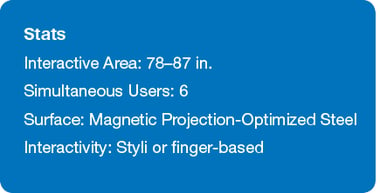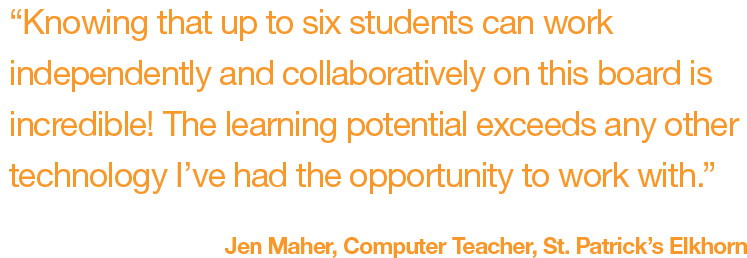
Whole-class learning is a key aspect of the modern classroom, but how do you find the right solution for your school? There are a variety of options, so you need to take a closer look at each one to determine which is the best choice for your students, teachers, curriculum, and budget.
 Last week we looked at interactive projectors, which offer large interactive spaces more affordably than flat panel displays. This week, we're going to explore interactive touch boards, which can be used as both a conventional whiteboard and a touch board. Some of the most important considerations are what will work for your classroom configurations and for the teaching and learning styles of your educators and students.
Last week we looked at interactive projectors, which offer large interactive spaces more affordably than flat panel displays. This week, we're going to explore interactive touch boards, which can be used as both a conventional whiteboard and a touch board. Some of the most important considerations are what will work for your classroom configurations and for the teaching and learning styles of your educators and students.
Is an Interactive Touch Board Right for Your Classroom?
Interactive touch boards give classrooms the erasable surface of a whiteboard along with the power of touch, making it a great choice for budgets that can’t afford an HD touch display. Pen-and-finger capability gives students multiple ways to work with the lesson content for a more engaging, hands-on experience. The steel surface supports magnets when used with dry erase, so teachers still have their whiteboard. In addition, several students can work together, providing a collaborative learning solution.

Pros
- Collaboration: The multi-point touch allows several students to work together, engaging students in collaborative learning.
- Flexibility: The erasable surface allows teachers to use this solution as both a conventional whiteboard and a touch board, maximizing classroom space.
- Affordability: The cost is lower than purchasing an interactive flat panel, so for some schools—especially if you already have projectors—this solution allows you to bring collaborative touch to your classrooms for less.
Cons
- Projector Required: The touch board requires a non-interactive projector, so you need to either already have one in the classroom or purchase one at the same time.

No matter what you are teaching with, new technology has one main purpose: to educate. While traditional tools can capably communicate knowledge and ideas, interactive solutions more easily engage today’s students and create countless opportunities for collaborative learning. You can read more about interactive projectors, along with a variety of other whole-class learning solutions, in our new Interactive Solutions in the Classroom guide. Click here to download your free guide today!


